CIVIL TECHNOLOGY: CONSTRUCTION GRADE 12 QUESTIONS - NSC EXAMS PAST PAPERS AND MEMOS NOVEMBER 2018
Share via Whatsapp Join our WhatsApp Group Join our Telegram GroupCIVIL TECHNOLOGY: CONSTRUCTION
GRADE 12
NSC EXAMS
PAST PAPERS AND MEMOS
NOVEMBER 2018
REQUIREMENTS:
- Drawing instruments
- A non-programmable calculator
- ANSWER BOOK
INSTRUCTIONS AND INFORMATION
- This question paper consists of SIX questions.
- Answer ALL the questions.
- Answer each question as a whole. Do NOT separate subsections of questions.
- Start the answer to EACH question on a NEW page.
- Do NOT write in the margins of the ANSWER BOOK.
- You may use sketches to illustrate your answers.
- Write ALL calculations and answers in the ANSWER BOOK or on the attached ANSWER SHEETS.
- Use the mark allocation as a guide to the length of your answers.
- Make drawings and sketches in pencil, fully dimensioned and neatly finished off with descriptive titles and notes to conform to the SANS/SABS Code of Practice for Building Drawings.
- For the purpose of this question paper, the size of a brick should be taken as 220 mm x 110 mm x 75 mm.
- Use your own discretion where dimensions and/or details have been omitted.
- Answer QUESTIONS 2, 3.7, 4.3, 5.2, 5.4, 6.2 and 6.6 on the attached ANSWER SHEETS using drawing instruments, where necessary.
- Write your CENTRE NUMBER and EXAMINATION NUMBER on every ANSWER SHEET and hand them in with your ANSWER BOOK, whether you have used them or not.
- Drawings in the question paper are NOT to scale due to electronic transfer.
- Google Images was used as the source for all photographs and pictures.
QUESTIONS
QUESTION 1: OHSA, MATERIALS, TOOLS, EQUIPMENT AND JOINING (GENERIC)
Start this question on a NEW page.
1.1 Choose a description from COLUMN B that matches an item in COLUMN A. Write only the letter (A–G) next to the question numbers (1.1.1 to 1.1.5) in the ANSWER BOOK, e.g. 1.1.6 H.
COLUMN A | COLUMN B |
1.1.1 Sole plate |
(5 x 1) (5) |
1.2 Describe TWO safety precautions that must be adhered to when working on a scaffold. (2)
1.3 What is the purpose of the guard rail of a scaffold in terms of safety? (2)
1.4 Explain the purpose of painting. (2)
1.5 Describe ONE advantage of the curing process of concrete. (1)
1.6 FIGURE 1.6 below shows a tool that is used in the building construction industry. 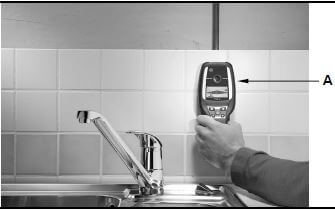
FIGURE 1.6
1.6.1 Identify tool A. (1)
1.6.2 Explain TWO uses of tool A. (2)
1.6.3 Explain why the batteries should be removed from the tool if the tool is not going to be used for a long time. (1)
1.7 FIGURE 1.7 below shows joining fixtures that are used on building sites and in workshops. 
FIGURE 1.7
1.7.1 Identify fastener A and fastener B. (2)
1.7.2 Explain ONE use of fastener A and fastener B respectively. (2) [20]
QUESTION 2: GRAPHICS AS METHOD OF COMMUNICATION (GENERIC)
FIGURE 2 on the next page shows different drawings that appear on a building plan. Analyse the drawings and complete the table on ANSWER SHEET 2.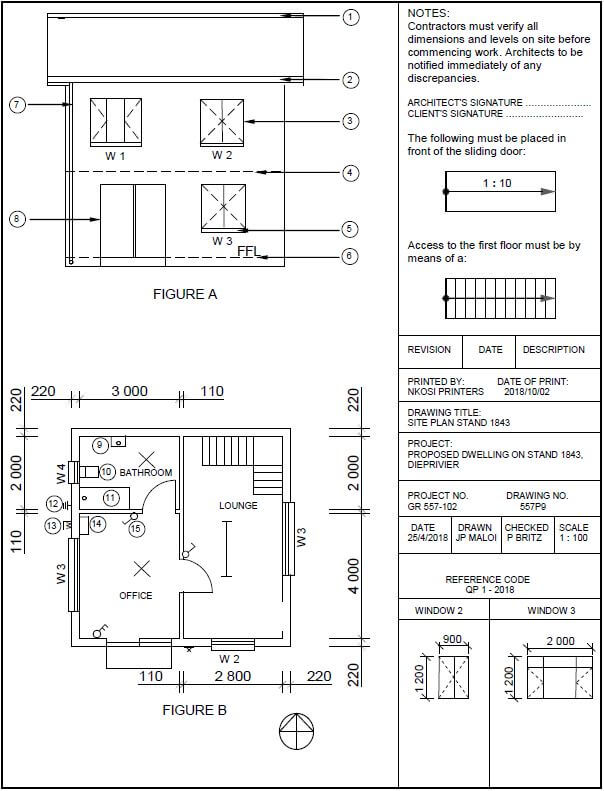
FIGURE 2 [40]
QUESTION 3: ROOFS, STAIRCASES AND JOINING (SPECIFIC)
Start this question on a NEW page.
3.1 What is the minimum pitch of a roof when class A corrugated iron sheeting are used to cover a roof? (1)
3.2 State the maximum distance for the spacing between roof trusses for corrugated iron roof sheeting. (1)
3.3 Differentiate between the timber used to fix a roof tile and roof sheeting by means of neat freehand drawings of EACH in your ANSWER BOOK. Print the correct name under each drawing. (2)
3.4 What are the measurements of a purlin for corrugated iron roof sheeting? (1)
3.5 Differentiate between the spacing of roof trusses for clay tiles and roof trusses for fibre-cement tiles. Copy the table below in your ANSWER BOOK. (2)
CLAY ROOF TILES | FIBRE-CEMENT TILES |
3.6 FIGURE 3.6 below shows a vertical cross section of a part of the construction at the ridge of a roof truss. Identify parts A–D. 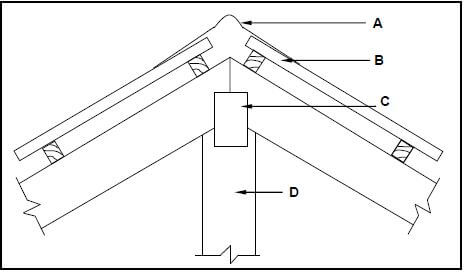
FIGURE 3.6 (4)
3.7 Use ANSWER SHEET 3.7 and draw, in good proportion, a neat sketch of a collar tie roof truss with a pitch of 45° resting on two supporting walls.
Show the following on your drawing:
- Walls
- Wall plates
- Rafters
- Collar beam/Collar tie
- Ridge beam (8)
3.8 Give ONE word/term for EACH of the following descriptions by choosing a word/term from the list below. Write only the word/term next to the question numbers (3.8.1 to 3.8.5) in the ANSWER BOOK, e.g. 3.8.6 Riser.
run; landing; nosing; going/tread; apron; riser; pitch line; baluster; handrail; stairwell |
3.8.1 The vertical distance between two consecutive treads (1)
3.8.2 Vertical posts that hold up the handrail (1)
3.8.3 The flat, horizontal surface of a step on which one walks when descending or ascending a stair case (1)
3.8.4 The top horizontal area on top of a staircase (1)
3 8.5 The horizontal distance covered by the stairs (1)
3.9 Draw a neat sketch, in good proportion, of a square and round profile that can be used for handrails in your ANSWER BOOK. (2)
3.10 Explain ONE method of mounting handrails onto a wall. (1)
3.11 Describe TWO methods of securing a wall plate to a brick wall. (2)
3.12 Steel sections can be joined to a concrete base by means of a base plate and steel pin connection. Explain the purpose of the pin in this joining method. (1) [30]
QUESTION 4: EXCAVATIONS, FORMWORK, TOOLS AND EQUIPMENT AND MATERIALS (SPECIFIC)
Start this question on a NEW page.
4.1 Choose a description from COLUMN B that matches an item in COLUMN A. Write only the letter (A–G) next to the question numbers (4.1.1 to 4.1.5) in the ANSWER BOOK, e.g. 4.1.6 H.
COLUMN A | COLUMN B |
4.1.1 Excavations |
(5 x 1) (5) |
4.2 Excavation of loose soil is necessary on a building site to reach a firmer soil base.
4.2.1 Explain THREE safety factors that should be considered after excavations have been completed. (3)
4.2.2 Describe THREE tasks that must be performed after the site inspection in order to prepare the site. (3)
4.3 FIGURE 4.3 on ANSWER SHEET 4.3 shows a trench that has been excavated.
Use ANSWER SHEET 4.3 and draw a neat sectional drawing, in good proportion, of the shuttering for firm soil.
Show the following on your drawing:
- Folding wedges
- Walling boards
- Poling boards
- Struts
- Any TWO labels (8)
4.4 Describe ONE property of good formwork. (1)
4.5 FIGURE 4.5 below shows formwork in the construction process. Study the drawing and answer the questions that follow. 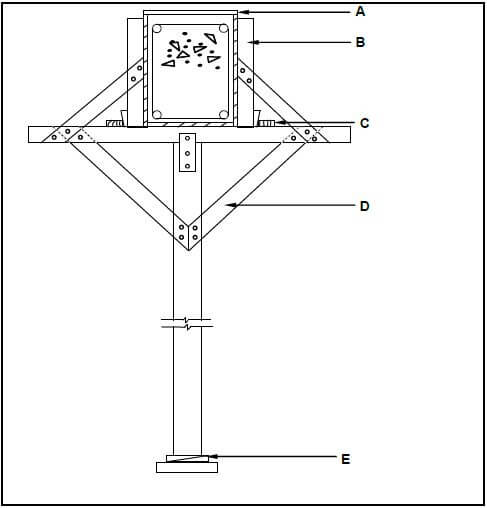
FIGURE 4.5
4.5.1 Identify the type of formwork in FIGURE 4.5. (1)
4.5.2 Name A to D. (4)
4.5.3 Justify the use of E. (1)
4.6 State TWO properties of steel shuttering. (2)
4.7 FIGURE 4.7 below shows a construction machine that is used on a building site.
Study FIGURE 4.7 and answer the questions that follow. 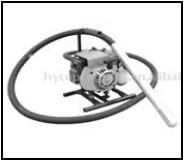
FIGURE 4.7
4.7.1 Describe TWO safety precautions that must be adhered to when using the machine in FIGURE 4.7. (2)
4.7.2 Explain, in your own words, how you will take care of this construction machine. (2)
4.8 FIGURE 4.8 below shows a machine that is used on a building site. State TWO ways in which you will take care of this machine. 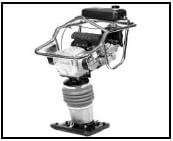
FIGURE 4.8 (2)
4.9 Describe TWO disadvantages of ready-mixed concrete. (2)
4.10 Explain TWO purposes of the slump test. (2)
4.11 Name TWO different types of methods that can be used for the curing of concrete. (2) [40]
QUESTION 5: PLASTER AND SCREED, BRICKWORK AND GRAPHICS AS MEANS OF COMMUNICATION (SPECIFIC)
Start this question on a NEW page.
5.1 FIGURE 5.1 below shows a worker plastering a wall. Study the drawing and answer the questions that follow. 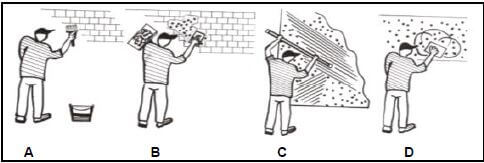
FIGURE 5.1
5.1.1 Describe the processes that take place from A to D. (4)
5.1.2 What type of tool is used in C? (1)
5.2 ANSWER SHEET 5.2 shows the outlines of the front and side views of a cavity wall. Use ANSWER SHEET 5.2 as a guide and draw FOUR courses of the external view of the cavity wall showing the front and left views. (6)
5.3 FIGURE 5.3 below shows TWO different paving patterns. Study the photographs and answer the questions that follow. 
FIGURE 5.3
5.3.1 Name paving patterns A and B. (2)
5.3.2 State ONE paving method that is commonly used. (1)
5.3.3 Describe the term jointing when laying paving bricks. (1)
5.4 Use ANSWER SHEET 5.4 and draw to a scale of 1 : 10 a detailed vertical section through the foot of a roof truss showing open eaves.
Show the following on your drawing:
- Wall: 220 mm wide, face brick
- Wall plate: 114 mm x 38 mm
- Tie beam: 114 mm x 38 mm
- Rafter: 114 mm x 38 mm
- Eaves overhang: 400 mm
- Purlins: 76 mm x 50 mm
- Corrugated iron roof covering
- Fascia board: 230 mm x 38 mm
Print the scale below the drawing.
Print any TWO labels on the drawing. (15) [30]
QUESTION 6: REINFORCEMENT IN CONCRETE, FOUNDATIONS, CONCRETE FLOORS AND QUANTITIES (SPECIFIC)
Start this question on a NEW page.
6.1 Various options are given as possible answers to the following questions. Choose the answer and write only the letter (A–D) next to the question numbers (6.1.1 to 6.1.5) in the ANSWER BOOK, e.g. 6.1.6 C.
6.1.1 Reinforcement is indicated on a construction drawing according to a code. In the code 9 R 16 01 200, the 200 indicates the …
- diameter of the bar.
- centre-to-centre spacing.
- number of bars in the group.
- bar number. (1)
6.1.2 Which of the following is a force that can act on a structure?
- Tensile force
- Compression force
- Shear force
- All the above-mentioned (1)
6.1.3 During the planning of a rib and block floor, the following need to be considered:
- Straightness of units
- Water absorbing properties of units
- Nature of props
- Cross bracing for sturdiness (1)
6.1.4 Steel tube caisson piles make use of a …
- wet concrete plug.
- casing driven into the ground.
- steel tip.
- precast concrete pile. (1)
6.1.5 Type of soil where precast piling can be used:
- Soft soil
- Firm soil
- Stable soil
- All the above-mentioned (1)
6.2 Use ANSWER SHEET 6.2 and draw a neat sectional view of a square reinforced concrete column in good proportion.
Show the following on your drawing:
- Column
- 8 main bars
- Stirrups/Binders
- Minimum concrete cover
- TWO labels (10)
6.3 State THREE advantages of using pile foundations. (3) 6.4 Explain the method of installing in situ driven piles. (3)
6.5 FIGURE 6.5 below shows material for a floor component. Study the diagram and answer the questions that follow. 
FIGURE 6.5
6.5.1 Identify the part in FIGURE 6.5. (1)
6.5.2 What is the purpose of the hole at A? (1)
6.5.3 Name the part that will fit in at B. (1)
6.5.4 Name THREE materials that are used for this type of floor construction. (3)
6.5.5 State ONE important safety factor that should be adhered to after the installation of this type of floor construction. (1)
6.5.6 Explain TWO disadvantages of this type of floor construction. (2)
6.6 FIGURE 6.6 below shows the floor plan of a storeroom with an opening for a door and a window. 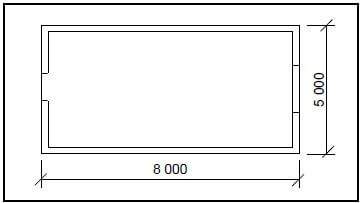
FIGURE 6.6
SPECIFICATIONS:
- Outside measurements of the storeroom: 8 000 mm x 5 000 mm
- The superstructure is a one-brick wall: 220 mm wide and 2 700 mm high
- Size of the opening for the window: 1 200 mm x 900 mm
- Size of the opening for the door: 2 100 mm x 900 mm
Use ANSWER SHEET 6.6 and calculate the following:
- Total length of the skirting for the store room (ignore the reveals) (6)
- Volume of screed for the floor if the screed is 25 mm thick (4)
Round off your answers to TWO decimal places. [40]
TOTAL: 200
EXAMINATION NUMBER: |
CENTRE NUMBER: |
ANSWER SHEET 2
NO. | QUESTIONS | ANSWERS | MARKS |
1 | Identify FIGURE A. | 1 | |
2 | Identify FIGURE B. | 1 | |
3 | Identify number 4. | 1 | |
4 | Identify number 5. | 1 | |
5 | Identify number 9. | 1 | |
6 | Identify number 10. | 1 | |
7 | Identify number 11. | 1 | |
8 | On what date was the plan printed? | 1 | |
9 | Who drew the building plan? | 1 | |
10 | Name the feature in the column for the notes in FIGURE 2 that must be installed in front of the sliding door. | 1 | |
11 | Name the feature in the column for the notes in FIGURE 2 that must give access to the first floor. | 1 | |
12 | Identify the type of roof that is used for the building in FIGURE A. | 1 | |
13 | Explain the purpose of number 1. | 1 | |
14 | Explain the purpose of number 2. | 1 |
| NO. | QUESTIONS | ANSWERS | MARKS |
15 | Explain the abbreviation FFL at number 6. | 1 | |
16 | Explain the purpose of number 7. | 1 | |
17 | Explain the meaning of the arrow on the feature that must be installed in front of the sliding door. | 1 | |
18 | Explain what is meant by 1 : 10 indicated on the symbol in the notes. | 1 | |
19 | Which room will feature 15 serve? | 1 | |
20 | Explain the short dashed lines on the windows. | 1 | |
21 | Deduce the height of window 2 from the window schedule. | 1 | |
22 | Deduce the width of window 3 from the window schedule. | 1 | |
23 | On what elevation of the building is the bathroom window situated? | 1 | |
24 | Differentiate between component number 3 and component number 8. | 2 | |
25 | Differentiate between the light in the lounge and the light in the bathroom. | 2 | |
26 | Recommend a suitable floor covering for the bathroom. | 1 | |
27 | Recommend an appropriate scale to which FIGURE A should be drawn, according to SANS. | 1 | |
28 | Recommend an alternative sanitary fitment to replace number 11 that will serve a similar purpose. | 1 |
29 | Calculate the internal area of the office in m². Show ALL calculations. | 3 | |
30 | Calculate the perimeter of the building. Show ALL calculations. | 7 | |
TOTAL | 40 |
CENTRE NUMBER: |
EXAMINATION NUMBER: |
ANSWER SHEET 3.7
ASSESSMENT CRITERIA | MARK | CANDIDATE'S MARK |
Walls | 2 | |
Wall plates | 2 | |
Rafters | 2 | |
Collar beam/Collar tie | 1 | |
Ridge beam correctly drawn | 1 | |
TOTAL: | 8 |
CENTRE NUMBER: |
EXAMINATION NUMBER: |
ANSWER SHEET 4.3 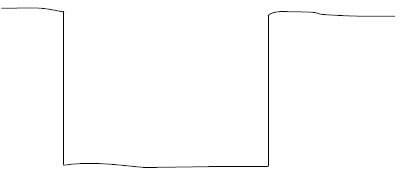
FIGURE 4.3
ASSESSMENT CRITERIA | MARK | CANDIDATE'S MARK |
Folding wedges | 1 | |
Walling boards | 1 | |
Poling boards | 2 | |
Struts | 1 | |
Shuttering correctly drawn | 1 | |
Any TWO labels | 2 | |
TOTAL: | 8 |
CENTRE NUMBER: |
EXAMINATION NUMBER: |
ANSWER SHEET 5.2 
ASSESSMENT CRITERIA | MARK | CANDIDATE'S MARK |
Full bricks and ½ brick every alternate course on front view | 4 | |
Left view full brick every course | 1 | |
Left view ¼ brick every course | 1 | |
TOTAL: | 6 |
CENTRE NUMBER: |
EXAMINATION NUMBER: |
ANSWER SHEET 5.4
ASSESSMENT CRITERIA | MARK | CANDIDATE'S MARK |
Wall: 220 mm wide, face brick | 1 | |
Beam filling | 1 | |
Wall plate: 114 mm x 38 mm | 1 | |
Tie beam: 114 mm x 38 mm | 1 | |
Rafter: 114 mm x 38 mm | 1 | |
Purlins: 76 mm x 50 mm | 2 | |
Corrugated iron roof covering | 1 | |
Fascia board: 230 mm x 38 mm | 1 | |
Any TWO labels | 2 | |
Print the scale below the drawing | 1 | |
Application of scale: | 3 | |
TOTAL: | 15 |
CENTRE NUMBER: |
EXAMINATION NUMBER: |
ANSWER SHEET 6.2
ASSESSMENT CRITERIA | MARK | CANDIDATE'S MARK |
Column 500 mm x 500 mm | 2 | |
8 main bars | 2 | |
Binders/Stirrups | 2 | |
Minimum concrete cover | 1 | |
Any TWO labels | 2 | |
Proportion | 1 | |
TOTAL: | 10 |
CENTRE NUMBER: |
EXAMINATION NUMBER: |
ANSWER SHEET 6.6
A | B | C | D |
Skirting: Inside length of building | |||
__________ - __________ | |||
= (2) | |||
Skirting: Inside width of the building | |||
__________ – __________ | |||
= _________ (2) | |||
Total length = ________ + _________x 2 | |||
= __________ | |||
= __________ - __________ | |||
= __________ metres of skirting needed (2) | |||
Screed: Inside area of building: | |||
1/ | _______ | ||
_______ | |||
_______ | ______ m³ | = _________ (4) | |